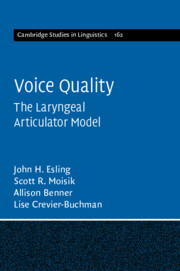Book contents
- Voice Quality
- Series page
- Cambridge Studies in Linguistics
- Voice Quality
- Copyright page
- Contents
- Figures
- Tables
- Preface
- Acknowledgements
- Abbreviations
- 1 Voice and Voice Quality
- 2 Laryngeal Voice Quality Classification
- 3 Instrumental Case Studies and Computational Simulations of Voice Quality
- 4 Linguistic, Paralinguistic, and Extralinguistic Illustrations of Voice Quality
- 5 Phonological Implications of Voice Quality Theory
- 6 Infant Acquisition of Speech and Voice Quality
- 7 Clinical Illustrations of Voice Quality
- 8 Laryngeal Articulation and Voice Quality in Sound Change, Language Ontogeny and Phylogeny
- References
- Author/Artist Index
- Subject Index
3 - Instrumental Case Studies and Computational Simulations of Voice Quality
Published online by Cambridge University Press: 21 June 2019
- Voice Quality
- Series page
- Cambridge Studies in Linguistics
- Voice Quality
- Copyright page
- Contents
- Figures
- Tables
- Preface
- Acknowledgements
- Abbreviations
- 1 Voice and Voice Quality
- 2 Laryngeal Voice Quality Classification
- 3 Instrumental Case Studies and Computational Simulations of Voice Quality
- 4 Linguistic, Paralinguistic, and Extralinguistic Illustrations of Voice Quality
- 5 Phonological Implications of Voice Quality Theory
- 6 Infant Acquisition of Speech and Voice Quality
- 7 Clinical Illustrations of Voice Quality
- 8 Laryngeal Articulation and Voice Quality in Sound Change, Language Ontogeny and Phylogeny
- References
- Author/Artist Index
- Subject Index
Summary
Instrumental phonetic techniques illustrate the analyses behind the interpretation of laryngeal articulator function and laryngeal sounds. High-speed laryngoscopy demonstrates aryepiglottic trilling. Cineradiography demonstrates where and how epiglottal stop and voiceless and voiced aryepiglottic trilling are generated. Simultaneous laryngoscopy and laryngeal ultrasound gauge the vertical displacement of the larynx during laryngeally constricted articulations compared to opening manoeuvres. MRI provides insight into the effects of lower-vocal-tract configurations on changes in vowel quality. Computational modelling shows how algorithms that account for voicing can be adapted to explain the mechanics of complex laryngeal vibrations. Vocal-ventricular fold coupling (VVFC) occurs as a vertical compression effect in stopping airflow and in constricted phonation types (creaky voice, harsh voice) and is modelled to illustrate the relationships and actions among laryngeal structures. Analyses, data capture, explanations of the algorithms, and videos of the working models are incorporated in the online companion materials, including articulatory simulations by the laryngeal component of the ‘ArtiSynth’ model.
Keywords
- Type
- Chapter
- Information
- Voice QualityThe Laryngeal Articulator Model, pp. 83 - 122Publisher: Cambridge University PressPrint publication year: 2019

